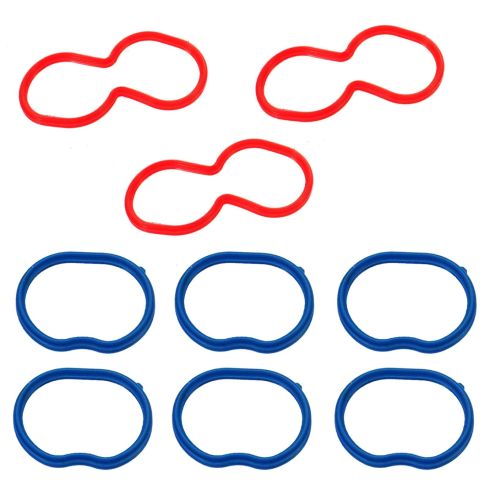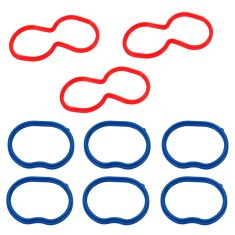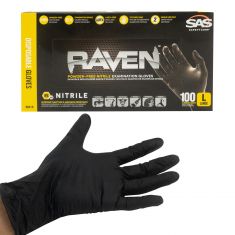Hi, I'm Mike from 1A Auto. We've been selling auto parts for over 30 years. We're dedicated to delivering quality auto parts, expert customer service, fast and free shipping, all backed by our 100% satisfaction guarantee. Visit us at 1AAuto.com, your trusted source for quality auto parts.
In this video, we're going to be working with our 2006 Chrysler 300 3.5 liter V6. We're going to show you how to remove and replace both of your vehicle's valve cover gaskets. These can be done individually. However, if you're already in there, it only takes a few more minutes to change the other one and be sure you don't have to take the top of the vehicle's engine off again. If you like this video, please click subscribe. We have a ton more information on this car as well as many other makes and models. If you need parts for your vehicle, you can follow the link down in the description over to 1AAuto.com. Here the items you'll need for this repair.
To remove your intake manifold we'll loosen the clamp at the throttle body with a flat blade screwdriver. You may want to disconnect this sensor. Looks like ours has been glued on because the clip is broken. You can also simply pop it out of the boot. Disconnect these two hoses from the back of the intake located just behind the throttle body. These just pop off by hand. There's one more at the back of the manifold.
Pull back on the red safety tab, push down and disconnect the sensor from the top of the intake, as well as the two electrical connectors at the front. Disconnect the connector from the throttle body. Again, we have one of those little red safety tabs we have to push down. Then we'll push down the tab and remove the connector.
We'll remove the two 10 millimeter nuts from the throttle body, the seven 10 millimeter bolts from the center of the intake manifold here, as well as the two 10 millimeter nuts over on the passenger side of the intake manifold. We'll do this using a 10 millimeter socket and ratchet where we can and a 10 millimeter wrench where it's a little too tight. Remove the two 15 millimeter bolts at the bottom of the throttle body bracket.
We're doing this with a 15 millimeter socket and ratchet. Remove the bracket from the throttle body. There's a 15 millimeter bolt at the bottom of the bracket on the passenger side of the intake manifold, both front and rear. We'll loosen those up with a 15 millimeter wrench until we can slide them off of the studs. Once you've loosened the brackets go ahead and slide them off the studs. Now we'll lift up on the intake manifold, slide it forward to release it from the EGR tube at the back. Once you're off that tube, lift up being careful for that transmission dipstick and remove the manifold from the vehicle.
While the top of the intake manifold is exposed we're going to wad some paper towels in there, just to keep any dirt and debris from getting in there while we're working.
Then you'll want to remove the electrical connectors for each injector which you do by popping up on the red tab until it releases, then pushing down on the black tab, and removing the connector from the injector. You'll repeat this process all the way around.
Disconnect all of your ignition coils by pushing down on the tab, removing the clip. Now we'll remove the 10-millimeter bolts on all of our coils. Remove them from the engine.
Remove the PCV hose from the back of the valve cover. Since we've removed it from our intake, we'll just take it right out, place it off to the side for now. Disconnect the knock sensor connector here. Make sure you put that up somewhere you'll see it so you don't forget to plug it back in.
Then we can lay this whole harness back and out of the way to remove this valve cover. Remove the eight 10 millimeter bolts on the outside edges of the valve cover: four on the top and four on the bottom. We'll do this using a 10-millimeter socket, ratchet, and extension.
There's also a 10 millimeter bolt on the outside center at the bottom of the valve cover gasket that secures two grounds. We'll have to remove that with our 10 millimeter socket and ratchet as well. It's very important that you remember to reconnect all of your grounds as leaving one little ground wire off could wreak havoc on the electrical system and leave you chasing a simple problem.
Using a flat blade screwdriver, pry up around the edges of the valve cover so it's released and remove it from the vehicle.
You may have to remove the intake tube here. We have an aftermarket intake, so we could just tilt it out of the way and remove our hardware. For those of you with the stock air box, you want to use a flat blade screwdriver to loosen this band clamp.
You'll also want to remove this breather hose from the engine, lift up, and remove all of these tabs securing the harness along the valve cover. There seems to be one for very stud except for this one. You may need a small flat blade to help you pry up on this. Move the harness out of the way of your valve cover and we'll need a deep 10-millimeter socket to remove these seven studs, the one 10-millimeter bolt securing the valve cover, as well as the 10 millimeter securing the ground on this side in the same location as the other.
Once all the hardware is loose, you do the same thing. Pry the valve cover up with a small flat blade screwdriver. Once everything is free, go ahead and remove it from the top of your vehicle.
Remove your old gasket from the valve cover. Now there are few schools of thinking here. Some people like to use a gasket sealer to keep it in place with just a couple little drops to hold the gasket into the valve cover. Some people like to use it as extra assurance by filling in this area and then installing their new gasket, coating the bottom of the gasket, and reinstalling the head. Any of these methods are fine. However, for people who don't have gasket sealer, a nice new gasket will do the exact same job for you.
All you have to do is line up the corners. You can see one end is shorter than the other here. Lay the channel in. You can see that we have this groove here. That's what's going to sit into the channel on the valve cover.
Now our gasket wasn't leaking, so we don't have any debris and oil down in here. If you do, clean it out. Make sure all of that is in there, nice and secure, and then we'll move on to removing our coil seals here.
Using a flat blade screwdriver, we'll get up onto the edges of the seal. You just want to wiggle the edge. You can see it lifting out here. These tend to get baked in there pretty good, so it may take a little bit of working to actually get it to come out. Once it's out, take your new seal. See that beveled end? It's going to face here. You just want to get that in. You should be able to push that in and install it fully by hand. Now we'll repeat this process with our remaining two coil holes and then the full process on the other valve cover.
Now this gasket is being a little stubborn, so what we're going to do to make sure it seats in fully and nice and flat is use this bearing and seal installer tool. If you don't have one, using a socket of the correct size or even a flat piece of steel or wood that fits nicely over that top edge and won't contact any of these angled portions will work just fine. We're going to set that on there. Just tap that down until it seats in fully. That's all it needs.
This one is the driver's side, so it includes our oil fill cap. Since that's plastic and we had to use some force to get those seals in, we'll remove that first. Don't forget to reinstall your oil cap after you've finished putting the gasket onto the driver's side valve cover.
Make sure that you wipe off the gasket surface on the cylinder head with a clean paper towel or rag and a little bit of solvent. I'm using a brake cleaner. You can use a variety of different solvents to remove the old dirt and debris. Make sure you don't let any chunks of paper towel or rag fall down into the cylinder head.
Once all that's clean, go ahead and reinstall your valve cover. Be careful that you don't pinch any of the wire harness underneath it. Another thing to be very careful with reinstalling the seals over the spark plug tubes, just put a little bit of down pressure using a pick. Just use that gasket around the tube. We'll do that with the rest of them as well.
Once that's set down into place, go ahead and start tightening down all of your 10 millimeter bolts. Torque your valve cover bolts to a 105 inch-pounds per manufacturer's specification or we're going with 9 foot-pounds because that's approximately what a 105 inch-pounds converts to. Don't forget to reinstall the ground along with its 10 millimeter bolt. You have two of them here both coming from down by the exhaust manifold. Reinstall your harness retainers and your breather tube. Again ours is a little bit different because of our aftermarket intake. We'll also reinstall our intake tube. Now I'm going to leave this loose for now just to make sure that it mounts back up to our intake properly.
Repeat these steps on the opposite side. Reinstall your wiring harness on to the top of the valve cover. Don't forget your 10 millimeter bolt with your two grounds down at the bottom. Make sure nothing is tangled up in there when you reinstall them either.
Reinstall all six of your coil packs. Tighten them down with a 10-millimeter socket and ratchet. Don't forget to reconnect the knock sensor at the back of the motor. Reinstall all of your fuel injector connectors. Don't forget to lock down the red safety tabs as well. Make sure they're all on there, good.
Remove the paper towels from the intake. Clean down this mating surface with some solvent and paper towels or a clean rag. Once again I'm using a brake cleaner here, but there's a variety of solvents you can use to get all that old debris and oil off.
Install your PCV breather tube on the back of the valve cover. You've got a nice little marking on it that says PCV with an arrow so you know which end goes where, and the other end should fall just about over here, where the back of the intake will be.
Remove the old gasket from your intake manifold using a small straight pick here, just to get in there and start popping it out. You should be able to remove the rest by hand. Start your new gasket. Line up. Press that in. Our old EGR seal is damaged so remove that. Install our new one. Make sure it sits all the way back past its edge.
Reinstall your intake manifold, being sure to set the opening for the automatic transmission dipstick into its proper place on the manifold. We'll also want to be careful for the bolts. We'll have to line up our EGR tube as well. Just be mindful of all of these things while we set it into place. Once the EGR tube is set and the intake is laid down onto the lower manifold, clip your automatic transmission dipstick back into place and start all of the 10 millimeter bolts by hand, just a couple of threads, to make sure they're all lined up before we tighten them down.
Tighten up the seven 10 millimeter bolts at the center of the intake. We're not going to tighten these down all the way yet. You just want them a little bit and then we'll have to torque them. Torque these bolts to nine foot-pounds. The manufacturer specification is 150 inch-pounds. However, it's a lot easier to do with this wrench and that number rounds up to about nine foot-pounds. We want to start these in the center and work our way out in a cross pattern.
Reconnect the map sensor. Push the safety into place. Reconnect the two intake tuner valve control. Reinstall the support brackets at the front and rear on the passenger side of the intake. We'll start those 10 millimeters on, just a couple of threads to keep it in place. Using a 15 millimeter socket and ratchet to tighten up those two bolts all the way at the bottom of those support brackets. Once the bottom of the support brackets are tighten down you can use the 10 millimeter socket and ratchet to finish tightening up the top two bolts.
Reconnect the PCV hose and this fitting closest to the EGR tube. We have a small hose here, and a large hose next to that. Reconnect the electrical connector onto the throttle body. Lock the safety tab back into place. You can now set the support bracket back over the throttle body bolts. Make sure it doesn't get caught up in any of the wiring down below. We'll spin our two 10 millimeter nuts on at the top by hand, just to keep that in place. Reinstall the two 15 millimeter bolts at the bottom of the bracket by hand. Tighten up the two 15 millimeter bolts at the bottom of the bracket with your socket and ratchet. Tighten up the two 10 millimeter nuts at the top.
Install the other end of the intake boot onto the throttle body. Tighten it up with your flat blade screwdriver. Reinstall the coolant tank line bracket on the side of the intake tube. Reinstall the map sensor into the intake tube. Earlier when we removed our intake, we wanted to wait until we had the intake tube reinstalled to make sure this all lined up properly. Now that we've got it where it needs to be we'll go ahead and tighten that down.
Thanks for watching. Visit us at 1AAuto.com for quality auto parts, fast and free shipping, and the best customer service in the industry.













